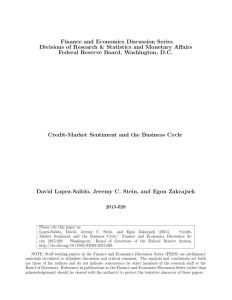Join getAbstract to access the summary!

Join getAbstract to access the summary!
David Lopez-Salido, Jeremy C. Stein and Egon Zakrajsek
Credit-Market Sentiment and the Business Cycle
Federal Reserve Board, 2015
What's inside?
If you want a crystal ball on the economy, look no further than to the clairvoyant credit market.
Recommendation
Stock markets might be notoriously unreliable predictors of economic activity, but credit markets seem quite accurate at forecasting the future. Economists David Lopez-Salido, Jeremy C. Stein and Egon Zakrajsek analyzed decades of American market data and found that if spreads are low and junk bonds are popular today, you can expect a downturn in two years. Exactly why this occurs is open to debate, the authors admit, but it’s a tidbit of intelligence that savvy investors might want to take under advisement. One caveat: With a few exceptions, this report’s turgid prose will be tough sledding for readers who don’t possess advanced training in economics. Nonetheless, getAbstract recommends it to investors and policy makers for its insight into credit markets and the economy.
Summary
About the Authors
David Lopez-Salido and Egon Zakrajsek are economists at the Federal Reserve. Jeremy C. Stein is an economics professor at Harvard University.



















Comment on this summary